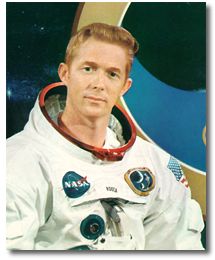- Stuart Roosa
Infobox Astronaut
name =Stuart Allen Roosa
type =Astronaut
nationality =American
date_birth =August 16 1933
date_death =death date and age|1994|12|12|1933|08|16
status =Deceased
place_birth =Durango, Colorado
place_death =Falls Church, Virginia
occupation =Test Pilot
rank =Colonel ,USAF
selection =1966 NASA Group
time =9d 00h 01m
mission =Apollo 14
insignia =
|Stuart Allen Roosa (
August 16 1933 –December 12 1994 ) was aNASA astronaut , who was the command module pilot for theApollo 14 mission. The mission lasted fromJanuary 31 toFebruary 9 1971 and was the third mission to land astronauts (Alan Shepard andEdgar Mitchell ) on theMoon . While Shepard and Mitchell spent two days on the lunar surface, Roosa conducted experiments from orbit in the command module "Kitty Hawk". He was one of only 24 men to have flown to the Moon.Roosa was born in
Durango, Colorado , and grew up inClaremore, Oklahoma . He attendedOklahoma State University and theUniversity of Arizona .Career
He started his career as a smoke jumper with the
U.S. Forest Service in the early 1950s. He joined theU.S. Air Force in 1953, attended Gunnery School atDel Rio Air Force Base ,Texas , andLuke Air Force Base ,Arizona , and was a graduate of the Aviation Cadet Program atWilliams Air Force Base , Arizona, where he received his flight training commission in the Air Force.From July 1962 to August 1964, Roosa was a maintenance flight test pilot at
Olmstead Air Force Base ,Pennsylvania , flying F-101 aircraft. He was a fighter pilot atLangley Air Force Base , VA, where he flew the F-84F and F-100 aircraft. He graduated from the Aerospace Test Pilots School and was an experimental test pilot atEdwards Air Force Base , CA from 1965 to 1966. Throughout his career, Roosa logged more than 5,500 hours of flying time (5,000 hours in jets) and 217 hours in space. He also served as chief of service engineering at Tachikawa Air Base, Japan, for two years following graduation from the University of Colorado, under the Air Force Institute of Technology Program.Roosa was one of 19 people selected as part of the astronaut class of 1966 and served as a member of the astronaut support crew for the
Apollo 9 mission. On Apollo 14 he spent 33 hours in solo orbit around the Moon, conducting an extensive series of experiments. His ability as a Command Module Pilot was put to the test when initial attempts to dock with the Lunar Module failed, and the problems were overcome only by Roosa's skill and careful coordination of the crew and ground controllers. He also carried tree seeds as part of a joint U.S. Forest Service/NASA project. The seeds were germinated on his return and planted throughout the United States, becoming known as the "Moon Trees".Following Apollo 14, he served as backup command module pilot for
Apollo 16 andApollo 17 , and based on crew rotations, would probably have commandedApollo 21 had it not been cancelled. He was assigned to the Space Shuttle program until his retirement as a Colonel from the Air Force in 1976. After leaving NASA and the Air Force, he held a number of positions in international and U.S. businesses, and became owner and president of Gulf Coast Coors in 1981.Honors and Awards
Roosa's honors include the
NASA Distinguished Service Medal ; the Johnson Space Center Superior Achievement Award (1970); the Air Force Command Pilot Astronaut Wings; theAir Force Distinguished Service Medal ; theArnold Air Society 's John F. Kennedy Award (1971); the City of New York Gold Medal (1971); the American Astronautical Society's Flight Achievement Award (1971); the Order of Tehad (1973); and the Order of the Central African Empire (1973). Additionally, an elementary school inClaremore, Oklahoma is named in his honor. Roosa earned a PMD fromHarvard Business School ,Cambridge, Massachusetts , in 1973 and an honorary LL.D. fromSt. Thomas University ,Houston in 1971.Death
Stuart Roosa died on
December 12 1994 inWashington D.C. due to complications frompancreatitis , aged 61. He was survived by his wife Joan, three sons and a daughter. He is buried in section 7A ofArlington National Cemetery . His wife Joan died onOctober 30 , 2007 in Gulfport, MS. She was interred at Arlington Cemetery with her husband Stuart.In the 1998 miniseries "From the Earth to the Moon", Roosa was played by
George Newbern ."Article based on [http://nssdc.gsfc.nasa.gov/planetary/text/roosa_pr.txt NASA press release 94-210] "
External links
* [http://www.jsc.nasa.gov/Bios/htmlbios/roosa-sa.html Official NASA biography]
* [http://www.arlingtoncemetery.net/saroosa.htm Arlington Cemetery biography and photos]
* [http://www.legacy.com/SunHerald/DeathNotices.asp?Page=Notice&PersonID=97097211]
Wikimedia Foundation. 2010.
